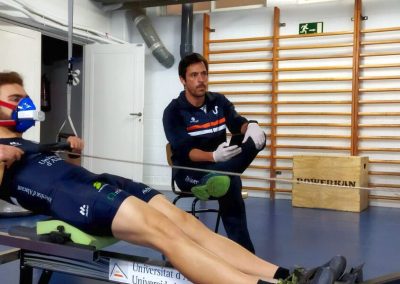Crystal O’Keefe: Welcome to the MetPro method podcast. I am your host, Crystal O’Keefe, and today I am joined by MetPro coach, Ryan Padilla. And we are going to be talking about time management, specifically for workouts. Ryan, thank you so much for being here today.
I personally have a lot of people ask me how to make time for their workouts. But you’ve been helping people design workouts for a long time. So, I figure you would have some really good information about helping people get set up, and how to help them get past excuses. How do we help them? How do we find the time for these people?
Ryan Padilla: Yes. I love this topic. It’s near and dear to my heart. And so it’s, tough to navigate, but I always love helping people find what fits their lifestyle. And really that’s the foundational topic that we’ll build off of today is, what’s best for you, but how do we keep in mind where we want to go with this exercise piece?
Crystal O’Keefe: That’s a good point because if you want to start, how do you decide what’s best for you? What questions does a person even need to think about? I know looking back at my journey over the years, I always just thought if you exercised, you would just get to the size you wanted to be or meet your goals.
But I didn’t even realize there could be more than one goal.
Ryan Padilla: Yeah, absolutely. And I think really what you’re describing is what a lot of people experience. And that’s just being overwhelmed by where do I start? Because I know where I want to be. And because that seems so overwhelming, it really can just be paralyzing.
It can paralyze that individual in their next steps. And so I think making it simple and realistic are the two things we have to look at, regardless of where you want to go or what your end result is with exercise. What is absolutely simple and realistic for me to accomplish right here and right now?
And that has to be the foundation that the building blocks are built from. And so that looks different for everybody. And that’s why, in my opinion, that’s going to be one of the most realistic approaches is by taking that
Crystal O’Keefe: stance. Okay. So let’s say I come to you, Ryan. I say, okay, I’m busy. I have no time. I want to work out. I don’t know how to fit it in. What is the most important factor that you tell me what do you do?
Ryan Padilla: Absolutely. So first, if you and I are having a conversation, my follow-up questions are: what does our week look like? What are the logistics of our lifestyle? And where can I plan?
Legitimately plan for myself to know that there’s a time and a place for me to treat as an important appointment, essentially where can I create time? Because if we’re being honest, the vast majority of us, or even all of us, do not have the time to exercise. But we have to create time for it. And that goes back to my, point of the foundation for right now, the realistic chance of that might be twice a week for 20 minutes.
Let’s find those two times twice this next week and let’s plan those. And then we didn’t go from there.
Crystal O’Keefe: So, first you find the time and then it’s okay, so if I say to you, okay I can fit in 45 minutes. You’re saying let’s find the time first. But once you find the time, does it matter?
Is it morning? Is it afternoon? Or does that completely depend on the person?
Ryan Padilla: It does. Now I’ll say this exercise timing, we can get really, it can matter and it can make a difference. But for somebody stepping into this, it doesn’t, we just have to accomplish it. And we have to collect those wins of building the momentum of getting it done.
And I would say nine and a half times out of ten, the timing doesn’t matter. It’s going to be accomplishing it and going from there. Because the way we exercise and how we exercise and the modality of exercise and all that, it matters down the road. But initially just starting with what’s realistic.
And so we can get into the person asking that question. The answer doesn’t matter. just due to their starting point with their current physical fitness and what they want to eventually accomplish. And that’s where we get into, well should do endurance training a little bit more or resistance training or what ratio of both those things am I going to establish?
Crystal O’Keefe: Yeah. And how do you know how to help people with that? Like, how do you direct them? First, you have to know that person, but if a person is trying to figure this out at home, what questions can they ask themselves or what questions should they be asking a trainer to get an idea?
Ryan Padilla: I think the questions you would ask yourself would be am I trying to- I think we got to simplify the questions we would ask ourselves. Are we trying to lose weight, aka improve our body composition? And if that’s the case, we probably want to start with some type of endurance/cardiovascular training.
And that might be walking. Essentially we’re just trying to increase our heart rate for a duration of time. And we have to be intentional about it. And we have to know where this time that I’m giving to this exercise session, I am going to increase my heart rate and keep it elevated for this amount of time.
And so that’s where I would prioritize at first is, a body composition or a weight loss client is looking to have endurance training as their primary modality. And then if fitting in resistance training is important too, obviously that requires a little bit more intentionality. But whether it be just machines at a gym or, simplified body weight exercises, those are things that could be worked in as well.
Crystal O’Keefe: Okay. And would you direct a person any differently if they came to you and said, I have 20 minutes a day versus a person who says I have 40 minutes a day?
Ryan Padilla: Yes, I think so. Because we want to get the biggest bang for our buck. We want to get out of that 20 minutes what we can because some people would look at that and say, Oh, I only have 20 minutes to give.
So is it really even worth it? The answer is always yes. That’s a time and place where you can actually use the word always. 20 minutes is always better than zero. And we can cause a lot of us can get caught in that all-or-nothing mindset, which we’ve talked about on this podcast a lot, and that applies to exercise as well.
Getting in 20 minutes is always better than none and still getting an elevated heart rate. It might even allow you to push yourself a little bit harder knowing that the duration is shorter. And so that’s also an outlook you could have for yourself in that type of situation.
Crystal O’Keefe: Okay. Those are good points. And what about people who say, “I know I need to work out. I have no motivation. What do I do?”
Ryan Padilla: I love that question because I think we’ve all been there at certain seasons of our lives in different times and places. But I think it comes down to accepting the fact that, well, first of all, it’s okay and very common to feel that way.
There’s nothing wrong with you feeling that way. And even the most disciplined people that I’ve known, or that as a person listening to this, all those people, they feel that way. I would say that on more days than not, they don’t feel like they want to work out. It just becomes who they are in a lifestyle, knowing the benefit that it brings to them.
And you’ll eventually get there, the person asking that question, but you have to accept that feeling that way is okay and is even expected. And then from there, it’s building habits and setting important appointments for yourself that this has, this is going to be a priority. And even though I don’t feel like I want to do it, this is going to get me where I want to go.
So it’s about knowing that there’s a difference between discipline over motivation. And it’s just being willfully taking that step, knowing that you’re investing in yourself and that those feelings will eventually change. But it comes down to that decision, but also, the most important thing is, acknowledging that’s very common to feel that way.
Crystal O’Keefe: When you say that, it makes me think about people who also go from not doing a lot of workouts or maybe they used to work out a lot and they’ve taken some time off. They’re getting back into it, but they have this goal in their mind of whatever it is, a lot of people, it tends to be losing weight, but it can be any goal.
The point being that they are now working out several times a week really, hard. And they don’t even recognize that they’re doing that. What are your thoughts about that? Is there a way for people to take a look at the workouts they’re doing and think about whether it is helpful to their long-term goals when you’re just looking at the intensity?
Ryan Padilla: I think when someone’s looking at the intensity of their workout because essentially, let me just be clear in what you’re asking. The intensity that they’re bringing, knowing that it’s pushing them to the goal they want. Is that what you’re asking? I think the answer to that question is like, there’s a term in exercise known as progressive overload.
And essentially it’s just working to get better at that task a little bit over time. And so in regards to an exercise session, whether it be an interval run, whether it be a timed walk that’s around the block of your neighborhood that you have a known start and a known finish, or whether it’s in the gym doing a resistance training on a specific movement.
What you’ll want to do is perform the exercise knowing what was accomplished during that time and then just little by little you are getting better so that way you have measurable results to build from. And if you’re getting better over those measured results over time, you’re working towards your goal.
The intensity comes from working towards the known improvement. And so that’s the best way for someone who doesn’t have a ton of experience or even does have experience. It helps you be intentional from where you started to where you’re going.
Crystal O’Keefe: Okay. So a little bit at a time. And I guess to that point, if a person hasn’t been working out a lot, they probably need to think about that as they start building their program. Do you have any tips or pointers for people who are just starting out? Like how intense, and how often they should be working out? Or, is it like just based on what you feel?
Ryan Padilla: It is based on what you feel, but I think at the same time, in the beginning, we’re vulnerable to not pushing ourselves like we could or should, essentially we should listen to our bodies. And I think all of us have the instinct to do that.
But at the same time, I think having accountability, whether it’s self accountability or an accountability partner whether that’s in the form of a coach or a friend. That’s important because it does push us and helps us advance to the next level of what we’re trying to accomplish. But knowing how to put that together, I think it comes back to the first point we made about, okay, what did I set as my realistic expectations and how do I build either in my intensity or my frequency in my workout regimen?
Frequency is going from two days to three or from three to four, and then intensity, which is where I initially like to start with clients, is picking up intensity before frequency because the time commitment stays the same. And what you accomplish in two sessions at 45 minutes. Let’s just pick up the difficulty level of that before we move to three days. So I like to pick up intensity before frequency.
But to answer your question, knowing where we started as realistic, then building in intensity and then in frequency can help that progressive overload that we just talked about.
Crystal O’Keefe: Okay. And what if you have people that go in the complete opposite direction? Like they’re pushing super hard. Do you have any thoughts about how they can keep an eye on that to make sure they don’t fall into that?
Ryan Padilla: Yeah, that does happen. I’m really glad you bring that up because I’ve worked with clients like that, and maybe they’re new, they don’t do nutrition well, but they are beasts in the gym. Like they train hard which is very cool to see. And I like these individuals for the fact that they have discipline created in their lives, but they’ve just got to channel that a little differently.
For those people that do feel beat down and maybe the results aren’t where they want to be considering rest is a valid thought. Because if we work hard and we push our body and we’re really, really, working to make change, the change doesn’t happen when we work out. The change happens when we put our body in an environment where it can recover and then grow or change or metabolism of muscle tissue and adipose tissue.
You’ve got to put it in the position in order for it to rest and change. As an example of a client that I worked with before, when I first met her, she had not taken a rest day in 22 or 23 days. I’m always an advocate for once we get to a certain point yeah, push yourself, go all out give, everything you have.
And so for me telling someone to take a mindset to pull back a little bit is difficult, but it’s very much needed in certain situations. But I always challenge that type of person to take that day off, give themselves rest, even if it’s active rest, and go for a walk.
And I really, like trust in the fact that you will actually start to gain better performance and start to see the progress that you want from pushing so hard by just giving your body the opportunity to recover more.
Crystal O’Keefe: Yeah. Like backing off a little bit to be able to go harder the next day.
Ryan Padilla: Yeah. And, really sometimes it’s a perspective because we really try to work harder and a lot of the time working harder is actually working smarter. Working smart is working hard because we can actually do things more optimally and efficiency is very much a precursor to, success when we’re talking about all of this.
Crystal O’Keefe: Yeah, especially when we’re talking about, we don’t have a lot of time, so you have to understand what is efficient for you as a person, what’s not overtraining, what’s using your time wisely and I think you’ve laid that out very well, that you have to think about all these different factors before you just get started.
So if people have time to plan their food, prep their food, or they have time to work out. But they don’t feel like they have time to do both. How would you recommend that they do that?
Ryan Padilla: Yeah, that’s a good question. And I’m asked that in a lot of different ways. So that’s funny that you bring that up because that’s a direct question, but that’s really… I get approached with that often in different situations and as much as I hate to say it, nutrition is the priority.
It has to be because like I just said, I’ve met a lot of people that work out a ton and their nutrition just is not where it needs to be, and they’re nowhere close to their goals. Some, in fact, have health concerns because of that. And exercise absolutely is crucial. But if our nutrition is not the foundation of our lifestyle, we are going to have a really, difficult time reaching our goals.
And in most cases, a lifestyle, a discipline with your food. That is absolutely so much more of a precursor to establishing exercise in your life. So to answer your question, it would be let’s, make food and nutrition the priority. And then we can have a better capacity to focus on nutrition.
And a lot of clients, they’ll even ask me, “Hey, Ryan, what are we talking about exercise?” Probably not for a couple of weeks, because I want to be confident that what is laid out for you is able to be executed. Because then when we talk about exercise, it’s not, things do not become overwhelming.
So food has to be number one.
Crystal O’Keefe: That makes a lot of sense. That makes a lot of sense. What did we miss? Is there anything you would like to add?
Ryan Padilla: Yeah, no, I could probably talk about this topic all day. Just in different ways. I think probably connecting some of these points we’ve already discussed, but the thing that I hear the most is, the time factor with setting up some sort of routine.
I think looking at what you accomplish each day, looking at where you invest your time and understanding that in order to get where you want to go, priorities have to shift a certain degree. So, where are we putting our time where are we investing? As human beings, regardless if we’re intentional with it or not, the things that are important to us are revealed by how we spend our time.
And so look how you’re spending your time and from there determine what you can sacrifice, what you can cut away, and where you can put exercise in. And a lot of self, maybe a lot, or even a little self-reflection can reveal that to you. But that goes to that first point we made about what’s realistic.
Sometimes we have to create what’s realistic by looking at our schedule.
Crystal O’Keefe: I have a client who gets up every morning at 4 a.m. to work out. That would not be realistic for me. Like, I know that about myself, but when I had a different work schedule once upon a time, I did get up every morning at five and that did work for me.
And so I, think that kind of playing around with it, some people need to do it right after work. Some people need to do it right before work. And I think you have a lot of really good points there. You have to try things out. You can’t just assume.
Ryan Padilla: Yeah. And just to further that, briefly seasons of life will change and your priorities are going to have to change in different seasons of life in there.
You can’t feel guilty about that. It’s just the part of continuing to keep your priorities, the main priorities. And from there we may have to have a calendar shift. We may have to, you know, there are so many examples that are out there, but yeah, you have to be open to knowing that it’s going to be uncomfortable for a little bit getting used to a new schedule.
But just like any other season of life you do get used to it and you can learn to execute and live your life really well after getting used to being uncomfortable for a little while.
Crystal O’Keefe: Yes. What an excellent point. Yeah. It’s temporary. That’s a good way to look at it.
Ryan Padilla: Absolutely. I love how you simplify my, several sentences, Crystal, just like, in three words, well, we could have just said that.
Crystal O’Keefe: No, no, that’s just me. That’s me reiterating what you’re saying. It’s perfect.
Ryan Padilla: I love it.
Crystal O’Keefe: Oh Ryan, I really appreciate your time today. Thank you so much. And listeners, that’s all for this week. You can find all of the MetPro Method episodes anywhere that you get podcasts, or you can go to MetPro.co/podcast.
Please be sure to rate the show and review that lets other people know what they can expect. And you can also learn more about MetPro@metpro.co. I’m your host, Crystal O’Keefe, and I’ll be back next week. Until then, remember, consistency is key.





